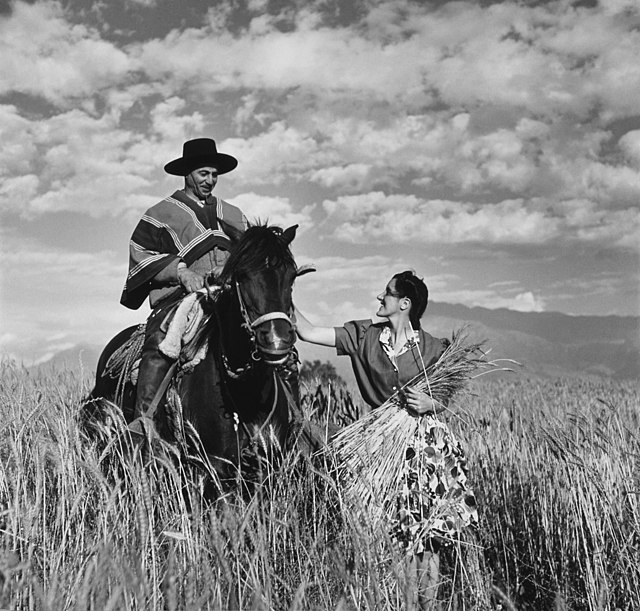Portal:Horses
Wikipedia portal for content related to Horses From Wikipedia, the free encyclopedia
Wikipedia portal for content related to Horses From Wikipedia, the free encyclopedia
The Horses PortalThe horse (Equus ferus caballus) is a domesticated, one-toed, hoofed mammal. It belongs to the taxonomic family Equidae and is one of two extant subspecies of Equus ferus. The horse has evolved over the past 45 to 55 million years from a small multi-toed creature, close to Eohippus, into the large, single-toed animal of today. Humans began domesticating horses around 4000 BCE, and their domestication is believed to have been widespread by 3000 BCE. Horses in the subspecies caballus are domesticated, although some domesticated populations live in the wild as feral horses. These feral populations are not true wild horses, which are horses that never have been domesticated and historically linked to the megafauna category of species. There is an extensive, specialized vocabulary used to describe equine-related concepts, covering everything from anatomy to life stages, size, colors, markings, breeds, locomotion, and behavior. Horses are adapted to run, allowing them to quickly escape predators, and possess a good sense of balance and a strong fight-or-flight response. Related to this need to flee from predators in the wild is an unusual trait: horses are able to sleep both standing up and lying down, with younger horses tending to sleep significantly more than adults. Female horses, called mares, carry their young for approximately 11 months and a young horse, called a foal, can stand and run shortly following birth. Most domesticated horses begin training under a saddle or in a harness between the ages of two and four. They reach full adult development by age five, and have an average lifespan of between 25 and 30 years. Horse breeds are loosely divided into three categories based on general temperament: spirited "hot bloods" with speed and endurance; "cold bloods", such as draft horses and some ponies, suitable for slow, heavy work; and "warmbloods", developed from crosses between hot bloods and cold bloods, often focusing on creating breeds for specific riding purposes, particularly in Europe. There are more than 300 breeds of horse in the world today, developed for many different uses. (Full article...) Entries here consist of Good and Featured articles, which meet a core set of high editorial standards.
Black Allan or Allan F-1 (1886 – 1910) was the foundation sire of the Tennessee Walking Horse. He was out of a Morgan and Thoroughbred cross mare named Maggie Marshall, a descendant of Figure and the Thoroughbred racing stallion Messenger; and sired by Allandorf, a Standardbred stallion descended from Hambletonian 10, also of the Messenger line. Black Allan was registered as No. 7623 by the American Trotting Registry. Although Black Allan was supposed to be a trotter, he preferred to pace, and so never raced. Besides the pace, he performed a lateral ambling gait now known as the running walk. (Full article...) Selected image A huaso in Chile. A huaso is a Chilean countryman and skilled horseman, similar to the Argentinian or Uruguayan gaucho, the American cowboy, and Mexican vaquero and charro. Latest updates
More did you know?
Related portalsEntries here consist of Good and Featured articles, which meet a core set of high editorial standards.
The Rocky Mountain Horse is a horse breed developed in the state of Kentucky in the United States. Despite its name, it originated not in the Rocky Mountains, but instead in the Appalachian Mountains. A foundation stallion, brought from the western United States to eastern Kentucky around 1890, began the Rocky Mountain type in the late 19th century. In the mid-20th century, a stallion named Old Tobe, owned by a prominent breeder, was used to develop the modern type; today most Rocky Mountain Horses trace back to this stallion. In 1986, the Rocky Mountain Horse Association was formed and by 2005 has registered over 12,000 horses. The breed is known for its preferred "chocolate" coat color and flaxen mane and tail, the result of the relatively rare silver dapple gene acting on a black coat, seen in much of the population. It also exhibits a four-beat ambling gait known as the "single-foot". Originally developed as a multi-purpose riding, driving and light draft horse, today it is used mainly for trail riding and working cattle. (Full article...) Did you know (auto-generated)
General imagesThe following are images from various horse-related articles on Wikipedia.
TopicsHorse • Pony • Asinus • Equus (genus) • Equidae • Zebra • Glossary of equestrian terms • List of horse breeds • Evolution of the horse • Domestication of the horse • Horse care • Stable • Horse training • Equestrianism • Horse tack • Saddle • Equine nutrition • Equine anatomy • Equine conformation • Equine coat color • Equine coat color genetics • Horse markings • Equine vision • Horse hoof • Horseshoe • Horse gait • Horse behavior • Horse breeding • Breed registry • Equine infectious anemia • Horse colic • Lameness • Laminitis • Horse slaughter • Horses in warfare • Arabian horse • Thoroughbred SubcategoriesNew articlesThis list was generated from these rules. Questions and feedback are always welcome! The search is being run daily with the most recent ~14 days of results. Note: Some articles may not be relevant to this project.
Rules | Match log | Results page (for watching) | Last updated: 2024-11-06 20:23 (UTC) Note: The list display can now be customized by each user. See List display personalization for details.
WikiProjectsAssociated WikimediaThe following Wikimedia Foundation sister projects provide more on this subject:
Discover Wikipedia using portals |
Seamless Wikipedia browsing. On steroids.
Every time you click a link to Wikipedia, Wiktionary or Wikiquote in your browser's search results, it will show the modern Wikiwand interface.
Wikiwand extension is a five stars, simple, with minimum permission required to keep your browsing private, safe and transparent.